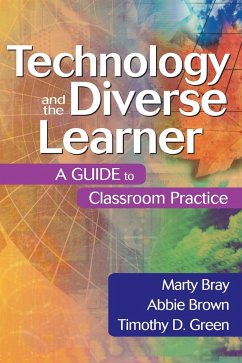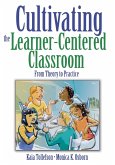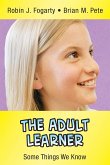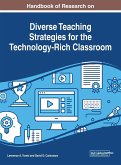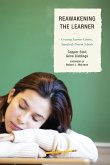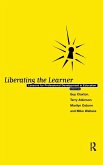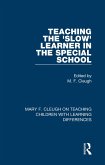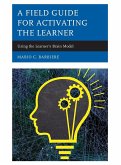Marty Bray, Abbie Brown, Timothy D. Green
Technology and the Diverse Learner
A Guide to Classroom Practice
Marty Bray, Abbie Brown, Timothy D. Green
Technology and the Diverse Learner
A Guide to Classroom Practice
- Gebundenes Buch
- Merkliste
- Auf die Merkliste
- Bewerten Bewerten
- Teilen
- Produkt teilen
- Produkterinnerung
- Produkterinnerung
Specifically designed for the K-12 inclusive classroom, this timely handbook demonstrates how to easily and effectively capitalize on available technology.
Andere Kunden interessierten sich auch für
![Cultivating the Learner-Centered Classroom Cultivating the Learner-Centered Classroom]() Kaia TollefsonCultivating the Learner-Centered Classroom40,99 €
Kaia TollefsonCultivating the Learner-Centered Classroom40,99 €![The Adult Learner The Adult Learner]() Robin J. FogartyThe Adult Learner27,99 €
Robin J. FogartyThe Adult Learner27,99 €![Handbook of Research on Diverse Teaching Strategies for the Technology-Rich Classroom Handbook of Research on Diverse Teaching Strategies for the Technology-Rich Classroom]() Handbook of Research on Diverse Teaching Strategies for the Technology-Rich Classroom306,99 €
Handbook of Research on Diverse Teaching Strategies for the Technology-Rich Classroom306,99 €![Re-Awakening the Learner Re-Awakening the Learner]() Copper StollRe-Awakening the Learner49,99 €
Copper StollRe-Awakening the Learner49,99 €![Liberating The Learner Liberating The Learner]() Liberating The Learner268,99 €
Liberating The Learner268,99 €![Teaching the 'Slow' Learner in the Special School Teaching the 'Slow' Learner in the Special School]() Teaching the 'Slow' Learner in the Special School180,99 €
Teaching the 'Slow' Learner in the Special School180,99 €![A Field Guide for Activating the Learner A Field Guide for Activating the Learner]() Mario C. BarbiereA Field Guide for Activating the Learner86,99 €
Mario C. BarbiereA Field Guide for Activating the Learner86,99 €-
-
-
Specifically designed for the K-12 inclusive classroom, this timely handbook demonstrates how to easily and effectively capitalize on available technology.
Hinweis: Dieser Artikel kann nur an eine deutsche Lieferadresse ausgeliefert werden.
Hinweis: Dieser Artikel kann nur an eine deutsche Lieferadresse ausgeliefert werden.
Produktdetails
- Produktdetails
- Verlag: Corwin
- Seitenzahl: 112
- Erscheinungstermin: 12. Mai 2004
- Englisch
- Abmessung: 260mm x 183mm x 11mm
- Gewicht: 422g
- ISBN-13: 9780761931713
- ISBN-10: 0761931716
- Artikelnr.: 21158590
- Herstellerkennzeichnung
- Books on Demand GmbH
- In de Tarpen 42
- 22848 Norderstedt
- info@bod.de
- 040 53433511
- Verlag: Corwin
- Seitenzahl: 112
- Erscheinungstermin: 12. Mai 2004
- Englisch
- Abmessung: 260mm x 183mm x 11mm
- Gewicht: 422g
- ISBN-13: 9780761931713
- ISBN-10: 0761931716
- Artikelnr.: 21158590
- Herstellerkennzeichnung
- Books on Demand GmbH
- In de Tarpen 42
- 22848 Norderstedt
- info@bod.de
- 040 53433511
Marty Bray holds a Ph.D. in Instructional Systems Technology from Indiana University, and an MLS from Appalachian State University. He also holds certification in the areas of Behaviorally/Emotionally Disabled and Academically Gifted. In addition to working with exceptional children Marty has also worked as a Media Coordinator in North Carolina. Currently, he is an associate professor in the department of Elementary and Bilingual Education at California State University, Fullerton.
Preface
About the Authors
1. Looking at Gender, Culture, and Other Diversities in the Classroom: An
Overview
Cultural Diversity
Gender
Differing Abilities: Exceptional Children
Standards and Guidelines
Summary
For Further Application
2. A Closer Look at Diverse Learners
English Language Learners/English as a Second Language Learners
Learners With Physical Disabilities or Impairments
Learners With Cognitive Impairments
Students With Learning Disabilities
Gifted and Talented Students
Summary
For Further Application
3. Diverse Learners and Innovative Technologies
Assistive/Adaptive Technologies
Supportive Technologies
Remediation Technologies
Compensatory Technologies
Extension Technologies
Summary
For Further Application
4. Curriculum, Technology, and Diverse Learners
Differentiated Instruction: What Is It and How Does It Work?
The Inclusive Classroom: An Overview
Technology and the Individual Education Plan
Cultural Sensitivity, Gender Equity, and the Use of Technology in the
Classroom
Using Technology With ELL Students
Gender Equity and the Use of Technology
Using Technology in the Content Areas to Facilitate Instruction With
Diverse Learners
Summary
For Further Application
Appendix A: Diverse Learners and Technologies
Appendix B: Diverse Learners and Instructional Strategies
References and Suggested Readings
Index
About the Authors
1. Looking at Gender, Culture, and Other Diversities in the Classroom: An
Overview
Cultural Diversity
Gender
Differing Abilities: Exceptional Children
Standards and Guidelines
Summary
For Further Application
2. A Closer Look at Diverse Learners
English Language Learners/English as a Second Language Learners
Learners With Physical Disabilities or Impairments
Learners With Cognitive Impairments
Students With Learning Disabilities
Gifted and Talented Students
Summary
For Further Application
3. Diverse Learners and Innovative Technologies
Assistive/Adaptive Technologies
Supportive Technologies
Remediation Technologies
Compensatory Technologies
Extension Technologies
Summary
For Further Application
4. Curriculum, Technology, and Diverse Learners
Differentiated Instruction: What Is It and How Does It Work?
The Inclusive Classroom: An Overview
Technology and the Individual Education Plan
Cultural Sensitivity, Gender Equity, and the Use of Technology in the
Classroom
Using Technology With ELL Students
Gender Equity and the Use of Technology
Using Technology in the Content Areas to Facilitate Instruction With
Diverse Learners
Summary
For Further Application
Appendix A: Diverse Learners and Technologies
Appendix B: Diverse Learners and Instructional Strategies
References and Suggested Readings
Index
Preface
About the Authors
1. Looking at Gender, Culture, and Other Diversities in the Classroom: An
Overview
Cultural Diversity
Gender
Differing Abilities: Exceptional Children
Standards and Guidelines
Summary
For Further Application
2. A Closer Look at Diverse Learners
English Language Learners/English as a Second Language Learners
Learners With Physical Disabilities or Impairments
Learners With Cognitive Impairments
Students With Learning Disabilities
Gifted and Talented Students
Summary
For Further Application
3. Diverse Learners and Innovative Technologies
Assistive/Adaptive Technologies
Supportive Technologies
Remediation Technologies
Compensatory Technologies
Extension Technologies
Summary
For Further Application
4. Curriculum, Technology, and Diverse Learners
Differentiated Instruction: What Is It and How Does It Work?
The Inclusive Classroom: An Overview
Technology and the Individual Education Plan
Cultural Sensitivity, Gender Equity, and the Use of Technology in the
Classroom
Using Technology With ELL Students
Gender Equity and the Use of Technology
Using Technology in the Content Areas to Facilitate Instruction With
Diverse Learners
Summary
For Further Application
Appendix A: Diverse Learners and Technologies
Appendix B: Diverse Learners and Instructional Strategies
References and Suggested Readings
Index
About the Authors
1. Looking at Gender, Culture, and Other Diversities in the Classroom: An
Overview
Cultural Diversity
Gender
Differing Abilities: Exceptional Children
Standards and Guidelines
Summary
For Further Application
2. A Closer Look at Diverse Learners
English Language Learners/English as a Second Language Learners
Learners With Physical Disabilities or Impairments
Learners With Cognitive Impairments
Students With Learning Disabilities
Gifted and Talented Students
Summary
For Further Application
3. Diverse Learners and Innovative Technologies
Assistive/Adaptive Technologies
Supportive Technologies
Remediation Technologies
Compensatory Technologies
Extension Technologies
Summary
For Further Application
4. Curriculum, Technology, and Diverse Learners
Differentiated Instruction: What Is It and How Does It Work?
The Inclusive Classroom: An Overview
Technology and the Individual Education Plan
Cultural Sensitivity, Gender Equity, and the Use of Technology in the
Classroom
Using Technology With ELL Students
Gender Equity and the Use of Technology
Using Technology in the Content Areas to Facilitate Instruction With
Diverse Learners
Summary
For Further Application
Appendix A: Diverse Learners and Technologies
Appendix B: Diverse Learners and Instructional Strategies
References and Suggested Readings
Index

